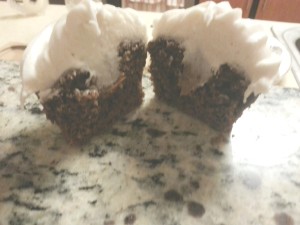By: Ryan Hodros, Culinary Arts and Pastry Arts Graduate

What you would be tasting is called Dulce de leche, which Wikipedia tells me means “candy made from milk.” Known as confiture de lait in France and kending gatas in the Philippines (it’s pretty big there), it comes about as the result of a combination of the caramelization of sugars and the Maillard reaction. It’s complex and interesting and, combined with a little salt, is vastly superior to the somewhat overrated spread mentioned in the first paragraph.
I first experienced Dulce de leche at a frozen yogurt store near where I grew up. Being something of a country bumpkin for most of my life, I often assume anything I found before I ventured out into the world is common knowledge for the rest of you urbane, worldly types. That’s why it came as such a surprise when I was doing some pastry demos for Greeley Central High School this past week, filling cupcakes with Dulce de leche, and none of the students had heard of it! “Alright,” I said, “maybe it’s because teens don’t really care about culinary exploration?” But I asked around, and a number of friends and family had also never heard of it. That’s when I decided to run this article—it’s a shame this wonderful confection isn’t more popular.
So how do you make it? Here’s what I do:
5 cans sweetened condensed milk
Water
A reliable timer
I say five cans, but that’s because only five will fit in the bottom of my stock pot. If you can fit more, do that, but don’t double-layer or you could have a disaster on your hands (see below).
Peel the labels off the cans and cover them in water so that they have at least two inches over the top, then bring to a boil on high heat. Drop to medium heat and cover. Set your timer for 30 minutes. When it goes off, check the water level to make sure the cans are still covered—if they’re not, add more tap-hot water to the pot so that they remain covered. Reset your timer for thirty minutes. Repeat this process until your cans have spent at least four hours in the boil, though 4.5 would be better. Let cool overnight and then use. (It’s easy, but it takes time.)
WARNING! Do not allow the water to boil away around your cans! Boiling water, through the magic of physics, can only reach a certain temperature (212 F at sea level). Fortunately your canned milk won’t explode at that temperature. Unfortunately, if the water boils away and your cans are left dry on the bottom of your stock pot, the temperature will keep rising until the can explodes, sending searing hot sugary milk all over your kitchen and everything (and everyone) inside. It’s tempting to cheat, setting the alarm for an hour instead of 30 minutes, but trust me—it’s not worth the risk.
So what can you do with it? The simplest applications are the best—spread it on toast to quiet your sweet tooth, pair it with peanut butter for a complex little snack, or use it like I did to fill cupcakes (use an apple corer or paring knife to cut a cavity into your cupcakes and pipe the Dulce into the space, then cover with frosting.)
If you want to get more complex, try baking off some simple sugar cookies rolled to about a quarter inch thick. Once cooled, sandwich the Dulce between two of the cookies and enjoy. OR you can try this on for size:
Dulce de Leche Frosting
8 oz Dulce de leche
4 oz butter
12 oz powdered sugar (varies)
1 t fine salt (not kosher or sea salt)
1 t vanilla extract (optional)
Let the butter and Dulce come to room temperature, then whip together until blended (you shouldn’t see any streaks of butter in the dulce, and the color should lighten). Add the salt and vanilla if you’re using it, and whip until incorporated. Add the powdered sugar in four parts, making sure to whip until you can’t see the powder anymore. If you want a thicker consistency, add more sugar. Put in a piping bag and refrigerate for five to ten minutes before using.
This goes great with pretty much any flavor of cake, but it really shines with simple flavors like chocolate or vanilla. The only fruit I’ve paired it with so far is cherry and strawberry (used as filling in a cupcake with the dulce frosting) so experiment! Shoot your suggestions to me on Twitter, and I’ll include them when I inevitably write about this stuff again (I love it!)



